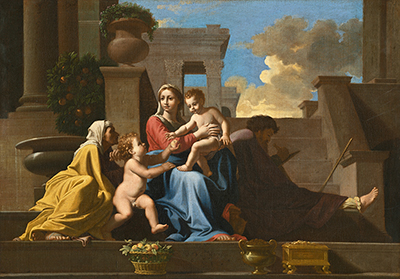Nicolas Poussin drew a representation illustrating the Holy family's role in redemption for humankind in 1648. The composition is currently at the Cleveland Museum of Art in Ohio.
The Holy family on the steps portrays the extended Holy family with Saint Elizabeth and John, who were frequent visitors. From the center, Holy Mary is seen presenting the child to the world, and above her shoulders stands a vase filled with unique flowers depicting humility. The open-air above Jesus' head creates a natural kind of nimbus representing glory. Saint Joseph stands at the right side, holding a compass as a symbol of God, the father, and director, and also to show his occupation as a carpenter. Though his representation is unusual for he appears more of an architect than a carpenter.
On the left side, Saint Elizabeth leans forward to foretell the baby's eventual death. Saint John the Baptist seems to be offering Jesus an apple signifying humanity's fall from grace in the Garden of Eden. The drawing is placed in an architectural setting to recall the traditional Rome as the idealized figures appear in a triangular grouping. Nicolas used geometric purity and a steep perspective to give the drawing a feeling of calmness and order.
Nicolas developed this composition using a combination of bright primary colors and geometric organization. He meticulously drew the image onto a canvas to express the great importance of the Holy family to Christian life. The background indicates his knowledge of adopting classical architecture into a religious theme. He was focused on achieving a harmonized composition, and he thus contained the figures in a triangular format, making Mary's and Jesus' heads the apex of the pyramid, which revealed his careful ordering of elements to focus on his composition.
He integrated the figures with their settings in an uncompromised way to come up with highly unified scenes across the dimensional surfaces. He is also known for posing small wax figures with cloth drapery inside a box with holes to let in light selectively, to determine how lighting defines form. The visual tension between surface designs and spaces brought out a great splendor and finality that ranks the image as a great masterpiece.
Nicolas Poussin drew his compositions from history and biblical stories. After moving to Rome during his early career life, Titian inspired him to paint in a hedonistic and perceptible style rich in color. He also surrounded himself with a lively group of rationales who became essential patrons and friends.




